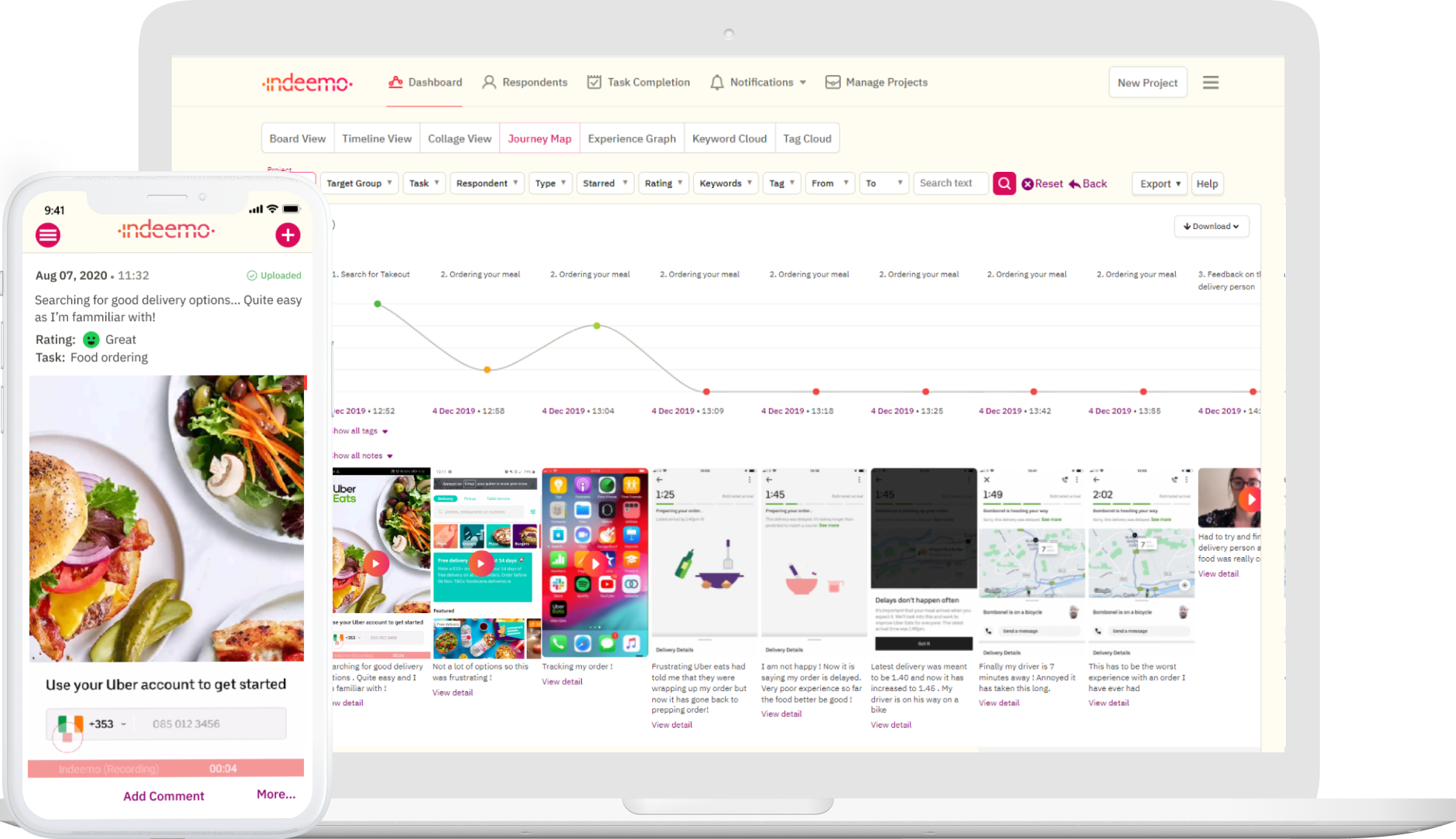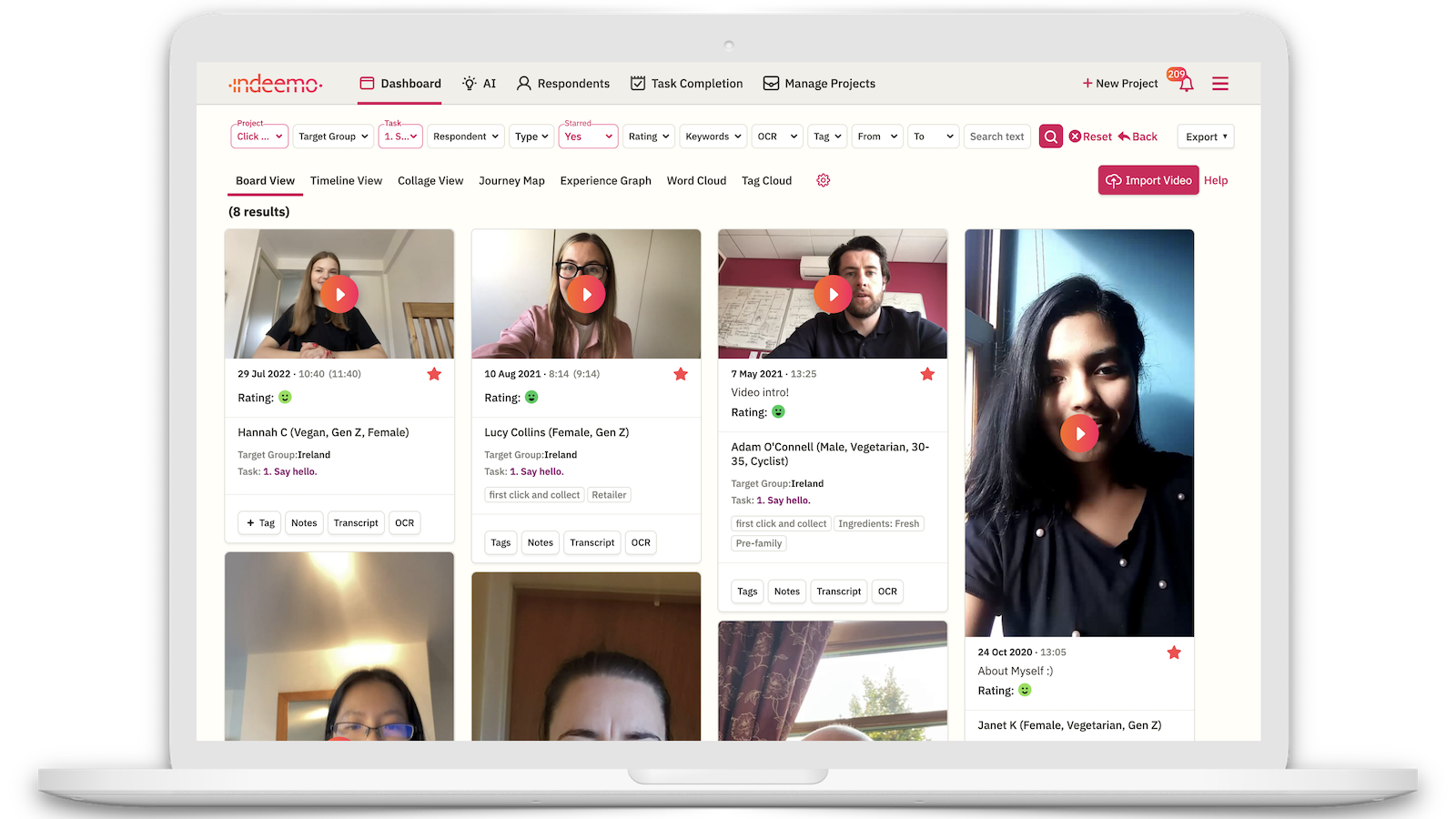Indeemo User Journey Mapping Dashboard
A UX diary study, rooted in the principles of qualitative research will result in rich insights that directly inform effective UX design. As a strong alternative to traditional quantitative user research methods, this what is and how to guide will help you and your team design a UX diary study protocol for your next user experience and user-centred design project.
What is a UX Diary Study?
So, what exactly is a UX Diary Study? A user diary, or user log, is a descriptive account of user activities. Unlike quantitative surveys, user diaries are used to explore the thoughts, feelings, behaviours that are integral to ux design.
Research participants in a ux diary study will document and record their experiences with a product or service. Although it appears straight forward, user engagement can be complex. With this in mind, a UX diary study can, and often does, encapsulate the user experience across multiple devices and channels where they interact with your product or service.
What is a Diary Study?
A UX diary study can be broad in the requirements asked of research participants. From the perspective of exploratory research, a ux diary study can be used to gather a deep understanding of user behaviours with a variety of products. An exploratory approach to user research will leverage the qualitative nature of a UX diary study. For example, your diary study can simply ask participants to document, photograph, or record their use of any interaction with online shopping.
In contrast, a UX diary study can focus on more specifics of user behaviour. A detailed diary study design typically requires research participants to capture their interactions with certain areas or features of a product. For example, users might be required to describe their thoughts and document their behaviour when they are at the check out of an online ordering system. This stage of a purchase journey might be a key piece of user engagement that your team needs to understand for future design.
A UX diary study can be impactful when your team uses an effective user research design strategy.
Conducting a UX research Diary Study
There is no one way to conduct UX diary research. In fact, a diary study can be iterative and is a flexible user research methodology. There are, however, a number of key principles we like to follow when designing and implementing a diary study.
Further reading
What is User Journey Mapping?Outline your UX Diary Study objective
The objective of your diary study requires some background research. Ask questions of your team. What do we already know about our users? What do we not know about our users? What behaviours do we need to capture? How long do we need to run our diary study for? In essence, you should want to build your research objective from previous found insights, and the unknowns you require answers to.
Bring all voices to the table
It is not uncommon for silos to form across an organisation. Silos can have implications when it comes to user research and UX design. For your UX diary study, it is important to understand the needs of all those who will use your insights. A UX designer will have requirements. A CX management team may need to learn about certain areas of a digital customer journey. Of course, most importantly, you want to put your users at the forefront. What have your users previously told about their experiences? What are their wishes for future design? For those questions you do not have answers for, build them into your research objective. The main thing here is that when you involve the voices of all stakeholders, it reduces the risk of missing out on required insights.
UX diary study duration and task design
Once you have outlined your research objective you will need to consider the duration of your diary study. Typically, a UX diary study is longitudinal. A longitudinal study can range between five days and six months, or even longer. Your research objective should direct you towards the best time frame for your diary study. It is important to consider the commitment required by research participants. Your diary study might ask participants to make diary entries once a day or more. The user activities refer to the tasks that participants complete for each user log. An extensive ux diary study can, but not always, increase the risk of participant drop off. This brings us to participant recruitment and incentives.
UX diary study recruitment and incentives
Some organisations will have a pool of past research participants that can be recruited for a new UX diary study. Others may not, and these organisations often work with a research recruitment agency that will help you reach the sample number needed. One of the benefits of qualitative research is that it does not depend on the results of a large sample size like quantitative methods do. Aim for six to ten participants. Of course, this is all relative to your required outcomes and research objective.
You may or may not use incentives for your diary study. At times, this all comes down to budget. The use of incentives, monetary or otherwise, reward participants for their participation in your UX diary study. Incentives can be given out as each user activity is completed or at the end of your study. Nonetheless, incentivising research participants will maximise user engagement for your diary study.
Benefits of UX Diary Studies
As an emerging qualitative methodology for user research, the benefits of a UX diary study uncover unknown insights about the user experience.
The power of contextual research
A UX diary study can leverage the empowerment given to research participants. What exactly do we mean by this? The difference between user interviews, or focus groups, and a ux diary study relates to the natural habits and behaviours of user engagement. Whereas a focus group aims to draw out how users feel about a product design or service as a collective, a diary study brings you into each of your research participants' lives. Contextual insights emerge quickly from the implementation of a UX diary study. User behaviour captured and described in a controlled setting might not reflect the user experience in the real world. With a diary study, research participants will typically exhibit true behaviours and are more open when describing the pain points in their diary.
Identifying User Personas
User personas play a central role in UX design. Each user persona will influence UX design. UX teams may already have existing user personas. There can be times when you require a review of your current user personas. User behaviours change, and audience segments shift when new products come to market and influence shape user needs. A UX diary study can be used effectively to help you identify emerging personas. A deep dive into user behaviour and habits can often capture previous unknowns to your team. Behavioural changes, pain points, and shared experiences across your research participants can prompt the emergence of new user personas.
Develop and share user empathy
A UX diary study presents you and your team with an abundance of textual, photographic, and video data. When research participants complete tasks or describe user activities, the context and in the moment characteristics of a UX diary study will always, without fail, bring you closer to your users. Empathy building is a result of the contextual insights that are captured through a diary study. Inclusive of all members of your team and various stakeholders, a sense of shared user empathy will drive the next phase of your UX design.
UX diary studies are unobtrusive
When we think of a UX diary study being unobtrusive, empowerment comes to mind. Traditional user research techniques, like user interviews, can limit the degree to which a research participant will share. Additionally, research participants may behave differently with a piece of design at a user lab than they would when they interact with the same design in their natural environment. A diary study reduces the researcher effect and empowers participants. To empower your users and research participants, you are giving them the freedom to express how they feel about your design without having eyes on them. To empower users, you give them the freedom to interact with your design in places where they are comfortable - at home, on the bus, at a cafe, and so on.









